by Editor | Feb 4, 2013 | Accomodations, New Articles
Article and photos by Josette King

The Trevi Fountain at night
On my first visit to Rome many decades ago I threw the obligatory coin over my shoulder into the Trevi Fountain. It worked. Every few years I seem to come across a new opportunity to return, any excuse will do. Most recently, it was a fortuitous three-day stopover during an extended tour of the region. I deliberately had no agenda other than roaming around the city to soak up the atmosphere of a few favorites spots, and discover new ones along the way. Located in the center of Rome, a five-minute walk from Stazione Termini (Termini for short), the central train station, bus terminal and subway station, and within walking distance from most of the major tourist landmarks, the Hotel Mediterraneo first caught my attention as an ideal base for my explorations; and quickly intrigued me for its Art Deco origins, an architectural style I had not until now associated with the Eternal City.
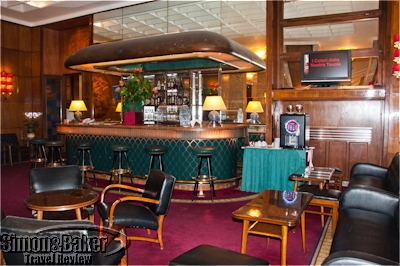
The bar at the Hotel Mediterraneo
Designed in 1936 by noted architect Mario Loreti for Maurizio Bettoja (then head of Bettoja Hotels), the property opened in 1942. To this day it remains the flagship of Bettoja Hotels, one of the oldest and largest family-owned hotel groups in Italy, now in its fifth generation. And with its original grandeur meticulously maintained by Maurizio’s successors, some consider the Mediterraneo among the finest examples of Art Deco architecture and rationalist design in Rome.
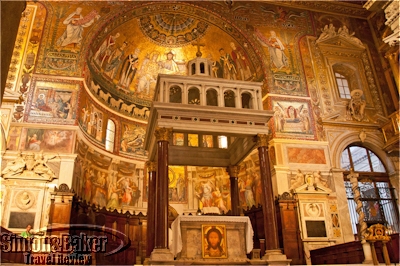
The Santa Maria Maggiore high altar
After a day of wandering through churches and palazzos filled with lavish millennia-old frescoes and extravagantly ornate carvings dripping with gold, the slick polished marble columns and exotic woods paneling of the airy and somewhat austere public spaces characteristic of the Art Deco style were a relaxing contrast. Common areas were filled with remarkable decorative elements of the era, and subtle reminders that, rationalism notwithstanding, eternal Rome endured.
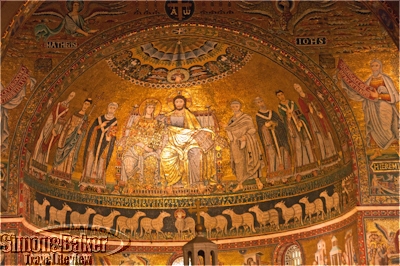
High altar Byzantine mosaic detail at Santa Maria Maggiore
In the lounge, a wall-size parchment map of an ancient perspective of the Mediterranean Sea was a reminder of the property’s name, as well as a nod to the Gallery of Maps at the Vatican. In the dining room, a stunning mosaic of a medieval hunt brought to mind the splendid tapestries of Renaissance palaces. Then there were the museum-worthy marble busts of Roman emperors interspersed throughout. I enjoyed walking through the majestic spaces and discovering new artistic details that had previously escaped my attention.
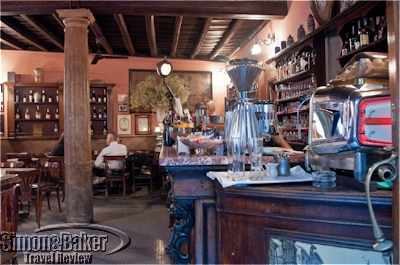
The Caffe della Pace
Although I discovered a new Rome favorite spot at the Mediterraneo, I didn’t neglect my old friends. I paid a neighborly visit to Santa Maria Maggiore. Built in the fifth century, this ancient Basilica still glows from the gold of byzantine mosaics that cover its triumphal arch and high altar. I headed to the Trevi Fountain for a quick nod of thanks. I couldn’t resist dropping by the Pantheon where for a few euros, tourists from around the world have their pictures taken with centurions in crimson capes and plastic armors. I stepped inside as well, to stand under the perfect rotunda and look up at the sky through its central oculus.
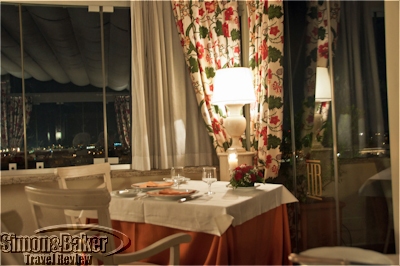
The Hotel Mediterraneo Roof Garden dining room at dinnertime
I went to Piazza Navona to take a fresh look at Bernini’s Fountain of the Four Rivers, which had been under wraps for repairs on two previous visits. Then I wandered into the old streets behind the Piazza, to the Caffe della Pace, a neighborhood favorite for over a century, in the street of that lent it its name, for a Spritz (popular local cocktail made of dry white wine, sparking water and bitter Aperol).
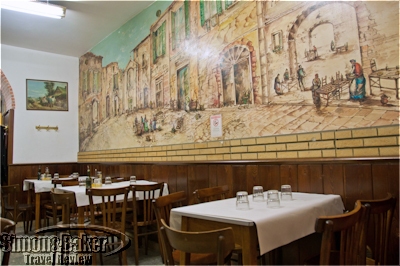
A favorite no-name fish eatery near Campo de Fiori
Thus reinvigorated I continued down the street to Santa Maria della Pace (Saint Mary of Peace) for a glimpse at the exquisite Raphael frescoes in the Chigi Chapel. I visited Campo de Fiori for the daily open market and the surrounding back streets where traditional artisans and avant-garde designers share the narrow storefronts and cobbled courtyards. And I stopped at a hole-in-the-wall fish place with paper tablecloths where market vendors drop in for a quick bite over high-decibel conversation, and neighborhood residents dash in for take-home fried fish. I don’t believe it has a name, but the fried calamari was out of this world.
by Editor | Jan 21, 2013 | Accomodations, New Articles, Restaurants
Article and photos by Josette King
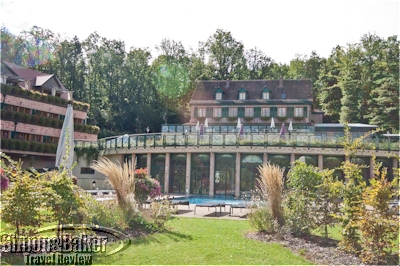
The property was located on three terraced levels
The Romantik Hotel and Spa les Violettes was the last stop on the itinerary of my recent visit to Alsace, France. I had spent a few days taking in the rich medieval art and architecture for which the area is renowned and enjoying its glorious wines and traditional cuisine (Paté de foie gras originated here in the 18th century). Les Violettes was just the right place to unwind before returning to Paris. Nestled in the densely forested foothills of the Vosges Mountains at the edge the Route des Vins (Alsace’s famed Wine Road), yet a mere 25 kilometers (16 miles) from Colmar, the property boasted superb spa facilities. In addition to three saunas with various heat and moisture levels, a steam room and whirlpool bath, there was an unusual halotherapy salt-cave and a grand counter-current indoor-outdoor pool that was a swimmer’s dream. The spa also had six private treatment rooms where it offered a range of massages, facials and body treatments.
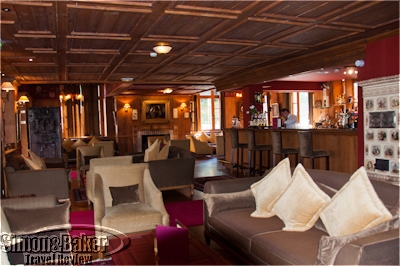
The Les Violettes bar sat in the corner of the open plan lounge
Then there was Le Jardin des Violettes, the property’s outstanding restaurant. In a region that has long held bragging rights for being home to an exceptional density of noted chefs and multi-award restaurants, Le Jardin des Violettes exceeded my expectations. The elegant dining room was decorated in warm shades of cinnabar and taupe that gave the formal space a cozy atmosphere. Subtle indirect lighting filled the room with a faint rosy glow that enhanced the formal table setting and provided just the right touch of romance to showcase the exciting creations of Chef Jérôme Jaeglé.
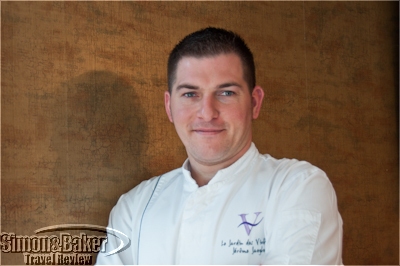
Chef Jerôme Jaeglé
Before taking over at Le Jardin des Violettes in early 2012, this talented young chef still in his early thirties, accumulated impressive credentials, including working as chef at Jean Yves Schilinger (a Colmar institution) and at Christian Têtedoie in Lyon. He found time to excel in some of the most respected French and international culinary competitions. A two-time winner of the National Taitinger Competition (in 2006 and 2008), recipient of a bronze medal in the Paul Bocuse European competition in 2010, he went on to take fourth place in the 2011 Bocuse Worldwide event. But through it all, this Colmar native maintained his passion for the bounty of the Alsatian countryside. During my visit, he explained that he lets the seasonable availability of locally sourced products guide his creativity. And he leads his team into foraging expeditions in the forests surrounding Les Violettes to gather the wild mushrooms and commercially unavailable greens that give his cuisine its unique cachet.
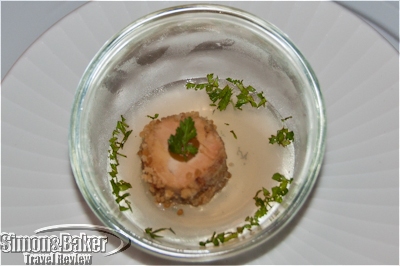
Foie gras on jellied green tea
I dined twice at Le Jardin des Violettes, and from amuse-bouche to dessert, each dish was an imaginative creation that delighted the eye and the palate. A light base of jellied green tea offset a rich nugget of paté de foie gras; chestnuts enhanced a wild mushroom duxelle, a simple mousseline of potatoes rose to the culinary stratosphere when whipped with walnut oil and garnished with oxalis (tiny wood sorrel leaves with a tangy, peppery taste). I can still taste a divine grilled filet of red snapper served with its skin deeply scored into julienne strips and caramelized crackling-style, while the tender white fish beneath was cooked to delicate perfection. And how could I forget his sublime cassolette (small casserole) filled with a fricassee of freshly gathered wild mushroom that concealed a farm-fresh egg softly poached in mushroom juices? Small wonder that Le Jardin des Violettes was awarded Two Toques from Gault et Millau in 2012.
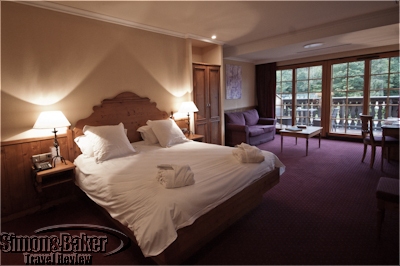
My room opened onto a large deck
The service was equally superb, unfailingly attentive yet unobtrusive. The extensive wine list included a wide selection of Alsatian wines as well as other wine-growing regions of France. From it, Alexandre Figenwald, the knowledgeable young sommelier, assisted us in selecting just the right bottles to enhance our meals (including a memorable Riesling Grand Cru Schlossberg 2010, Domaine Weinbach, Kayserberg). The one drawback of having experienced Chef Jaeglé’s cuisine is that it has become a personal benchmark against which most restaurants I have visited since Le Jardin des Violettes find it hard to measure up.
by Editor | Jan 7, 2013 | Accomodations, Attractions, New Articles
Article and photos by Josette King

La Petite Venise was once home to tanners and fishmongers
Alsace, this strip of fertile plain stretched along the western bank of the Rhine River in the northeastern corner of France, is a region long on history and charm. The object of a millennium-long tug-of-war between France and Germany, it has successfully integrated elements of both cultures into a unique personality: decidedly French but with a noticeable German flavor in its architecture, arts, cuisine and traditions. And in spite of its troubled past, it has managed to preserve most of its cultural patrimony. Nowhere is that more evident than in Colmar, the medieval architecture gem in the heart of La Route des Vins, the much-visited hundred-mile country road that meanders north to south through the Alsatian vineyards.
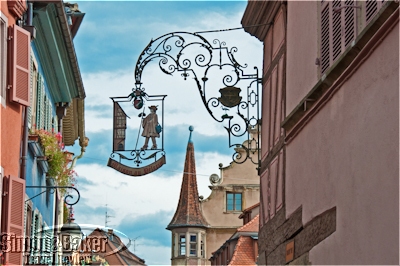
Antique wrought iron signs are still a common sight in Colmar
Mainly spared the destruction of the French revolution and two world wars, Colmar has an exceptionally large and well-preserved historic center for a city its size (population 65,000). I appreciated its laidback small town joviality and its easily walkable cobblestone streets lined with architectural treasures that span eight centuries of combined French and German evolution. At the edge of the historic town, the especially picturesque La Petite Venise (Little Venice) neighborhood is clustered around a network of canals from the River Lauch, where tanners and fishmongers quarters were once located. Farmers also used these waterways to ferry their products to the town market in small pole-propelled wooden barges. Similar barges are in operation today, with silent electric motors, to allow visitors a close look at the ancient (and still inhabited) riverside homes.
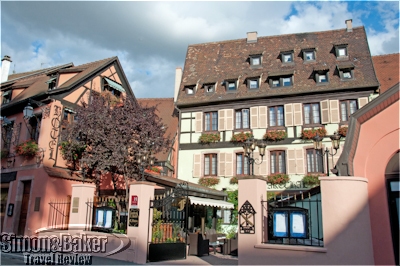
Romantik Hotel Le Maréchal opened onto a private courtyard
One of the finest historic properties of La Petite Venise is the picture perfect Romatink Hotel Le Maréchal. The luxury hotel was created from four adjoining 16th century half-timbered houses with their steep tiled roofs and neat rows of windows underlined with flower boxes overflowing with red geraniums. The rear of the hotel abuts the edge of the river, while the façade opens onto a small private courtyard. Inside, common walls have been opened and passageways link the various common areas with a maze of cozy nooks filled with antiques. An elevator is discretely tucked in a remote corner. My room, located under the eaves at the very top of the property, had slanted beamed ceilings and dormer windows that overlooked the roofs of the old town.
With its rustic Alsatian décor (discretely enhanced by 21st century amenities) it was a charming nest that beautifully captured the romance of the historic city. Equally appealing L’Echevin Restaurant occupied the entire rear of the first floor. There the space had been cleverly distributed to form a long, intimate dining room lined with picture windows that overlooked the river. It provided a worthy setting for the excellent cuisine of Chef Thierry Chefdeville, who has officiated in the kitchen for over a decade, earning such coveted recognitions as two toques from Gault et Millau and three forks from Michelin along the way, and firmly establishing L’Echevin’s standing as a noted destination for Alsatian gastronomy.
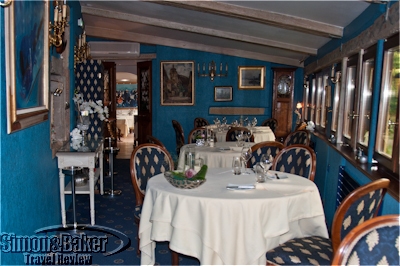
The restaurant, L’Echevin, overlooked the river Lauch
The pleasure of my stay at Le Maréchal, along with a couple of superb dinners at L’Echevin and the opportunity to wander at leisure around neighborhoods of meticulously maintained medieval houses would be reason enough for a weekend break in Colmar, especially now that several daily TGVs (Train à Grande Vitesse) have made it an easy three-hour and twenty minutes ride from Paris. But on this recent visit, there was also the lure of the town’s foremost artistic treasure: the Unterlinden Museum. Housed in a 13th century Dominican Sisters’ convent that is in itself a fine example of Gothic conventional architecture, the Unterlinden Museum holds a rich collection of Upper-Rhenish medieval and early renaissance sculptures and paintings.
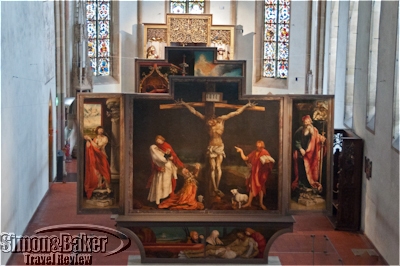
Matthias Grünewald’s masterpiece, the Isenheim Altarpiece is on display at the Unterlinden Museum
In addition to works by Lucas Cranach the Elder and Albrecht Dürer, it features several notable altarpieces by 15th century native son Martin Schongauer, and above all what is widely acknowledged as early 16th century master Matthias Grünewald’s greatest achievement: the Isenheim Altarpiece. Originally painted in 1512-1516 for the Monastery of Saint Anthony in Isenheim near Colmar, this unique oil on wood triptych has a center panel 2,70 meter (8 foot 10 inches) high by 3,10 meter (10 feet) wide depicting an especially poignant crucifixion scene. It was customary at the time for such triptychs to open to reveal additional scenes inside.
In the case of the Isenheim Altarpiece, there are actually two sets of wings, therefore two interiors. The first is a set of four panels depicting various scenes featuring the Virgin and Christ. The second interior is a carved shrine containing a polychrome sculpture of Saint Anthony flanked by Saints Augustine and Jerome, by sculptor Nicholas von Hagenau, with two more paintings (the Meeting of Saints Anthony and Paul, and the Torment of Saint Anthony) on the wings to the left and right respectively. In anticipation of its 500th anniversary, the masterpiece had been removed from view for restoration in recent years, and returned on display earlier this year.
by Editor | Oct 22, 2012 | Accomodations, Attractions, Restaurants and Food, Spas
Article and photos by Elena del Valle
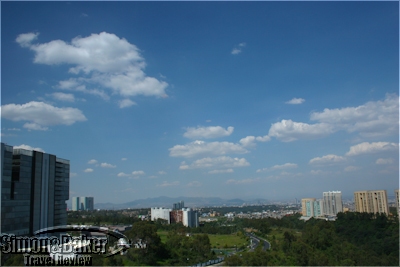
The view from the rooftop of our Santa Fe hotel
It had been years since my last visit to Mexico City. After the immigration desk I made my way into the customs area where I first noticed the new airport building. I later discovered Terminal 2, spacious and new looking, was only several years old and said to already be struggling to accommodate traffic. After a few minutes my suitcase rolled out and I walked to the customs area where my luggage, check-in and carry-on, had to pass through an x-ray machine. Then I was asked to press a green button before I could continue. Depending on the response I might be subjected to further inspection, one of the customs staff explained.

From the rooftop of The Westin I watched the sunrise over Santa Fe
No further inspection was required although my wireless keyboard attracted the customs staff attention for some reason. As I exited the customs area I searched the crowd for someone with a sign. Fidencio, my driver that day, and an assistant greeted me warmly. From the airport to The Westin Santa Fe Mexico City (Av. Javier Barros Sierra # 540, Lomas de Santa Fe, Mexico City 01219 México, DF, +52 55 50 89 80 00, fax +52 55 50 89 80 58, www.westin.com/santafe, westin.santafe@westin.com), my hotel for the first night, the private transport took 90 minutes. As we drove I looked around and realized I hardly recognized the traffic jammed buzzing metropolis. From my tenth story 34 square meter Deluxe Room, on a Starwood Preferred Guest floor, I had a splendid view of Santa Fe, a recently built booming business neighborhood. The hotel itself had only been established in August 2010.

There were flower arrangements in the hotel common areas
Dinner with the group of four I was joining, wasn’t for several hours so I ordered a room service club sandwich with fries. Within minutes I was munching the hot and yummy comfort food and a few welcome sweets I found in my room to tide me over until dinner. From Santa Fe to the La Roma neighborhood multi-level home of Chef Monica Patiño where we were having a private dinner it was an hour’s drive, less on the drive back once the traffic had quieted down.
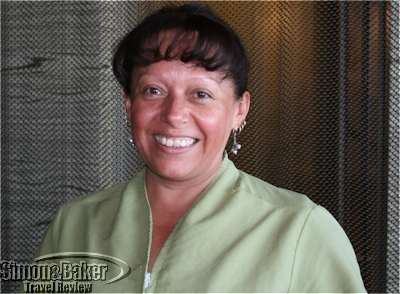
Griselda, my masseuse at Heavenly Spa
The following morning I rose early to catch the colorful sunrise view and work out at the hotel gym on the top floor before heading to the buffet breakfast at the ground floor restaurant. By 10:30 a.m. I was enjoying a good deep tissue massage with mini facial (not a favorite) courtesy of Griselda at the Heavenly Spa Westin, the hotel’s penthouse spa.
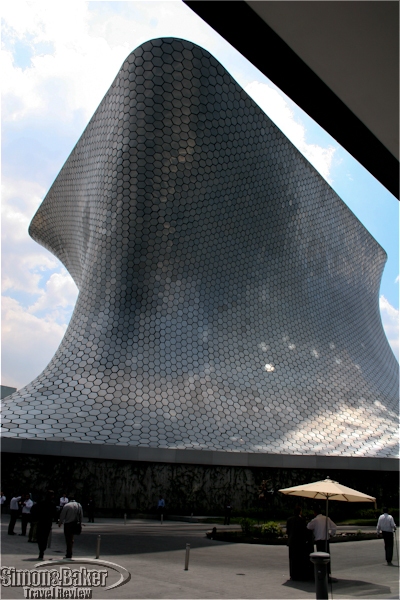
The exterior of the Soumaya Museum
By midday we checked out, leaving Santa Fe behind, making our way through heavy traffic for one hour to Museo Soumaya (Soumaya Museum), a 14-month old six-story structure housing fine art originals, mostly European and Mexican.
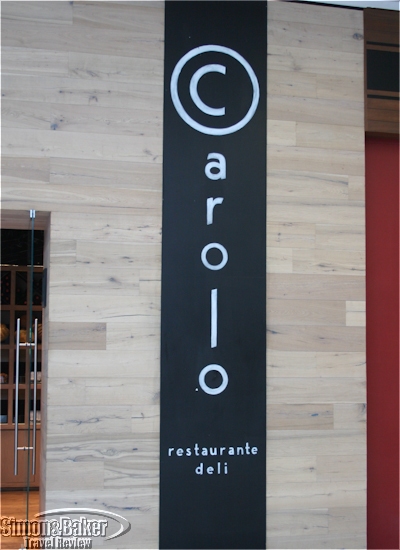
The entrance to Carolo Carso within a shopping mall and mixed use complex
From the museum we walked to Carolo Carso (Miguel de Cervantes Saavedra 303, Polanco, Mexico City, D.F., 11529, Mexico, +52 55 49 76 01 34, www.carolo.com.mx, info@carolo.com.mx), a Mediterranean style open air casual restaurant with an upper level view of the museum, within a large mixed use complex. It was one of several Carolo restaurants in the Mexican capital. Lunch consisted of a series of appetizer style dishes shared by the table occupants: Ensalada Chop (Chop Salad), Cuadritos de Atún (Tuna Squares), Mosaico de Salmones (Salmon Plate), Carpaccio de Res (Beef Carpaccio), Tacos de Rib Eye (Rib Eye Tacos), Tacos de Pato (Duck Tacos), Pizza Margarita (Margarita Pizza, a favorite), Risotto de Alcachofa (Artichoke Risotto, a favorite), Tostadas Orientales (Oriental Toasts), and Carmarones a los Tres Chiles (Shrimps in a Three Chili Sauce). Desserts too were set in the middle of the table for communal sharing: Pastel de Coco (Coconut Pie), Príncipe Alberto (Prince Albert Cake), Key Lime Pie, and Pastel de Tres Leches (Three Milks Cake).
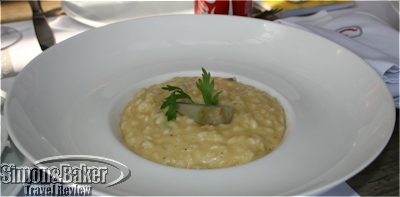
Artichoke Risotto
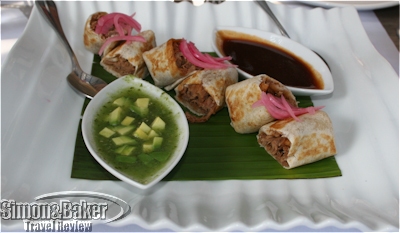
Lunch at Carolo Carso
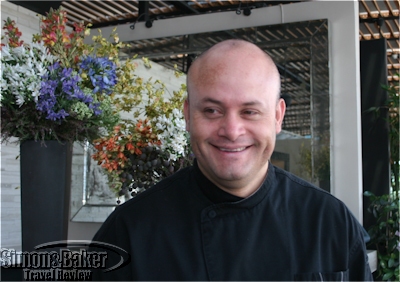
Marco de la O, executive chef, Carolo Group
At the end of the meal we had an opportunity to meet Marco de la O, executive chef, Carolo Group. A native of Puerto Vallarta, Jalisco he studied at the Universidad Anáhuac and at Panamericana de Hotelería in Mexico. De la O, who strives for excellence in quality, flavor and presentation, started his career at the Nikko Hotel in Mexico City. Later he worked at the Four Seasons in New York before returning to Mexico City.
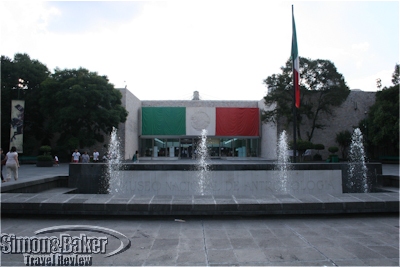
The entrance of the Anthropology Museum
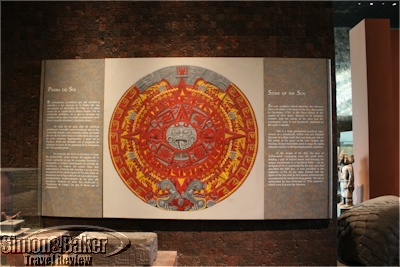
A representation of the Stone of the Sun at the Anthropology Museum
After lunch, we headed to the famous Anthropology Museum (Museo de Antropología) where Laura, a knowledgeable and patient guide escorted us to the Sala Maya (Maya Hall) for an outstanding, though brief because we arrived late, guided visit. A thirty minute drive saw us at the entrance of The St. Regis Mexico City hotel (Paseo de la Reforma 439 Colonia Cuauhtemoc Mexico City, Federal District 06500,Mexico, +52 55 52 28 18 18, fax +52 55 52 28 18 26, www.stregis.com/mexicocity, mexico.city@stregis.com) facing the Diana the Hunter (Diana La Cazadora) roundabout water fountain for check-in on the third floor of the tall building.
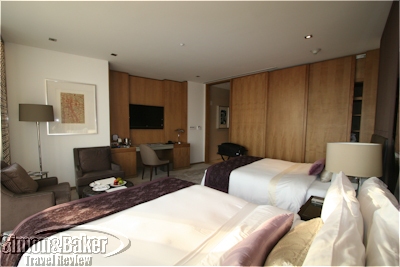
My room at The St. Regis Mexico City
The hotel’s spacious common areas were filled with sunlight, works of art and pretty flower arrangements. Friendly uniformed staff greeted us when we reached the lobby and escorted us to our respective accommodations following check-in procedures. The floor destination had to be selected on an outer panel with the electronic key card before entering the elevator, my staff escort explained.
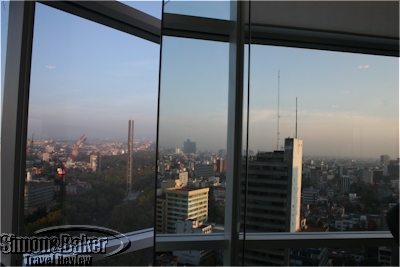
Mexico City seen from the St. Regis gym
Among my favorite features of the hotel were the lobby level views of the water fountain and the panoramic views of the city from the 15 floor work out rooms and adjacent pool area. From my twelfth story 50 square meter (538 square foot) Deluxe Room, on a Starwood Preferred Guest floor, I had a splendid view of Paseo de la Reforma and the surrounding neighborhood. Muted city sounds reached inside. Complimentary amenities on my floor were butler service, on demand 24-hour complimentary hot beverage service and the pressing of two items during my stay, my butler explained. The dimly lit room decorated in natural colors had thick double curtains to fend of the harsh sunlight, two double beds with thick plush mattresses and feather pillows, and a spacious marble bathroom with bathtub and separate shower, as well as a small remote controlled television screen built into the oversize mirror behind and between twin sinks. The new looking hotel dated to August 2009.

A black bean and foie gras appetizer at Dulce Patria
Dulce Patria restaurant (Anatole France 100, Col. Polanco, 11560, Mexico City, Mexico, +52 55 33 00 39 99, fax +52 55 33 00 39 95, www.dulcepatriamexico.com, kosberg@dulcepatriamexico.com), where we had a refined Mexican meal, was only twenty minutes from the St. Regis. Shortly after breakfast the following day we drove forty-five minutes across town to the Mercado de San Angel, a large covered odorous market filled with fruit and vegetable, fish, meat and a variety of other vendors.
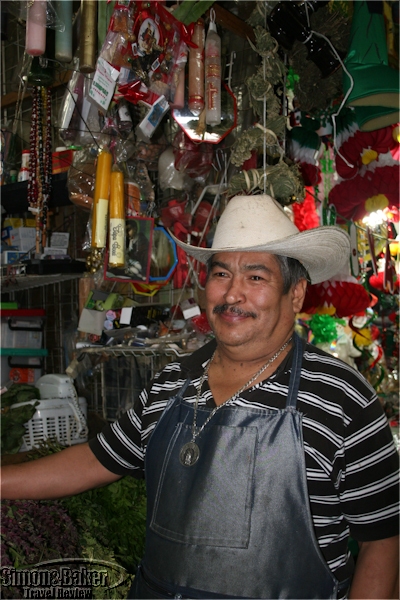
Margarito Angeles Ramirez sold herbs at the market
Our first stop was at the stall of Margarito Angeles Ramirez who, after learning the skill from his grandmother, for 22 years had sold herb blends at the Mexico City market. A large mound of fragrant fresh herbs occupied the front of his stall which was chock full of items all the way to the rear wall and from the ceiling down. A variety of amulets, candles, dried herbs and plastic wrapped items took up most of the small space that was sandwiched between other market vendors down a narrow passageway. While we learned about his services, in Spanish, from Margarito several customers came by, squeezing through the tight space where we stood, to pick up their herb blends and orders.
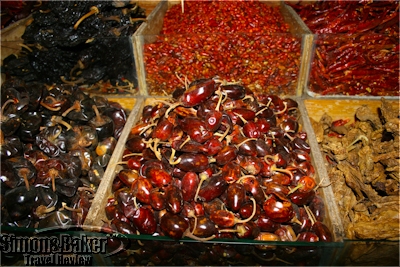
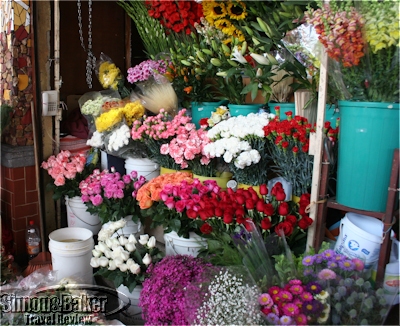
Vendor stalls at the Mercado de San Angel
With herbal blends, Angeles Ramirez said, he could, like a pharmacist, alleviate ailments such as allergies, migraines, headaches, indigestion and minor aches. He also provided mystical or magical white magic Santeria potions for good luck charms, attraction, and love. Prices ranged from five pesos to twenty thousand pesos. Some blends could be prepared while the customers waited while others required twenty days to be ready.

An unusual stop
From the market a short walk led us to the Public Baths (Baño Público), a fee based public steam and Turkish bath facility the owner kindly, if reluctantly, allowed us to visit. The San Jacinto Parrish (Parroquia de San Jacinto) was our next stop. Built atop an Indian temple the church, our guide explained, was important because it was at commercial crossroads of the 1500s. The church, as many others in the city, he said, had suffered severe damage in the early twentieth century although several original structures remained.
From the church we walked back a few blocks to the Saturday Bazaar (Bazaar del Sábado), a popular weekly indoor and outdoor arts and crafts market, where we spent the better part of an hour before heading to lunch at Azul Condesa, one of several Azul restaurants headed by Chef Ricardo Muñoz Zurita, in the Condesa neighborhood.

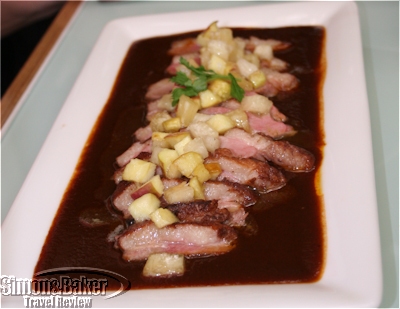
Favorite dishes at Azul Condesa
At lunch, we sat in an open air interior courtyard. Every table was full and the volume was so loud I could only hear my immediate neighbors at the table. Appetizers included several Yucatan dishes: Sope de Cochinita Pibil, a bite size morsel of succulent shredded pork topped with red onions that had been marinated in Yucatan bitter orange atop a sope, corn made bread cooked on a skillet; Sope de Hongos, a mushroom topped sope; and Salpicón de Venado, a European venison morsel made with onion, tomato, spicy chilies served with avocado and tortilla chips. My favorite was the Sope de Cochinita Pibil.
For starter I ordered the creamy Cream of Cilantro Soup served with toasted almonds, one of few non hot items on the menu. I sampled my neighbor’s juicy Duck Confit served with a red berry and plum sauce (a favorite) and my own dish, Roasted Skirt Steak served with home fries. From the dessert menu the server recommended Soursop Foam with a red berry sauce. Chili candies were served with coffee at the end of the meal.
by Editor | Sep 17, 2012 | Accomodations, Spas
By Laura Scheiber
Photos by Matthew Harris
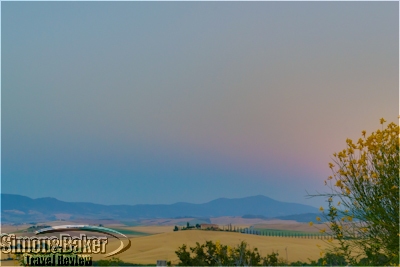
The Tuscan countryside surrounding Adler Thermae
As if the idyllic Tuscan countryside was not enough reason for my husband and I to visit the Val d’Orcia region of Italy, we could not wait to enjoy the natural thermal waters in the town of Bagno Vignoni, recognized for their healing benefits since Etruscan and Roman times. With thermal waters in mind we spent three wonderful days at Adler Thermae Spa & Relax Resort in Tuscany, Italy. With access to the local thermal springs, and couched between Pienza, a Tuscan medieval town specializing in pecorino cheeses, and the town of Montalcino, home of Brunello wine, the resort was ideally located to take advantage of many Tuscan delights.
For us, the highlights of Adler Thermae Spa & Relax Resort were the views of the breathtaking scenery, the consistently friendly service, and the endless opportunities to relax and rejuvenate. By the time we left, we felt mentally and physically recharged. Promising ourselves that we would return to this family-friendly haven, we have since recommended the resort to several friends and family members in search of a restorative getaway.

Brunello wine from Montalcino
Arriving on a sunny hot day in June after an hour’s drive from Siena, we checked in at the front desk, where Federika, one of the friendly receptionists, gave us an overview and map of the facilities, keys to our room and information on how to pick up our spa towels, size appropriate robes, flip flops, and a beach bag to be used throughout our stay.
The bellman escorted us to room 328, a 35 square meter room facing the pool area, with excellent views of the Tuscan countryside. The air-conditioned room was comfortable and pleasant. Had there not been so many wonderful facilities to explore, we happily would have kicked our feet up and relaxed in the sun-filled room, which had two twin-sized beds pushed together to make an oversized bed, and a small sitting area with a couch, tea table, arm chair, desk and chair.
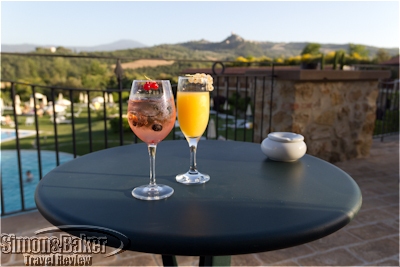
We enjoyed complimentary cocktails on the outdoor patio
After settling in, we went to the bar area for a complimentary welcome drink. Taking in the unobstructed views on the outdoor patio, I drank a refreshing fruit juice while my husband enjoyed a mixed drink made of Prosecco and Martini rosé. Since we had been steadily eating our way through Italy for the previous four days, I decided to take advantage of the indoor gym before dinner. Just like our room and the bar lounge, the most delightful feature of the well-equipped indoor gym was the fantastic view of the Tuscan countryside.
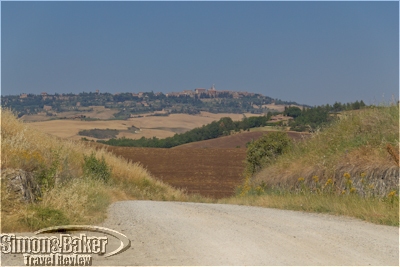
A view of Pienza while riding bikes through the countryside
The next day we were anxious to explore the landscape, so we reserved some of the complimentary mountain bikes the hotel offered. The receptionist gave us safety helmets and a map of several nearby bike routes. Within minutes we were on a secluded trail, surrounded by open fields of wheat and cypress trees swaying in the breeze, all beneath a perfectly blue sky. After conquering a few small hills, we were rewarded with a beautiful view of Pienza, atop a hillside 17 kilometers from Adler Thermae. Though we wanted to cycle to the peak we conceded to the 95 Fahrenheit degree heat and headed back to the resort for some pool time.
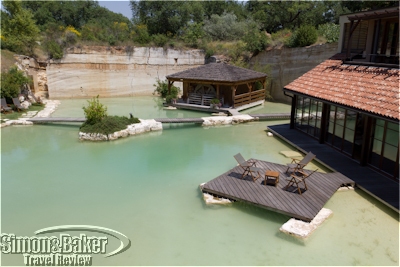
The outdoor spa area at Adler Thermae
After napping on the white loungers next to the 25-meter sports pool, I decided to take a dip in the outdoor thermal pool, sourced from one of the local thermal springs. I had read that the minerals had positive health benefits for joints and bones so I slipped into the 98.6 degree Fahrenheit water and made my way over to one of the areas where a row of thick iron rods served as a lounging seat. Water shot out of the side walls in twenty minute intervals, providing a massage of sorts. I laid my head back to take in the Tuscan sun and slipped into a wonderful state of relaxation.
On our last day at Adler Thermae, we wanted to take full advantage of the resort’s many facilities. I began with some laps in the outdoor 25-meter sports pool at a refreshing 82 degrees Fahrenheit. Although tempted by the 30-minute hydro bike class (one of six daily exercise classes offered by the resort during our stay), I opted for the outdoor treadmills just a few steps away from the pool area. Even after three days at the resort, I still marveled at the beautiful scenery and understood why the Val D’Orcia region of Tuscany was made a UNESCO World Heritage site.

Outdoor treadmills at Adler Thermae
After working out, my husband and I visited the sauna and steam rooms in the garden area of the spa. Located in a serene outdoor space of the resort, several humidity rooms surrounded an attractive thermal water pool. We visited the Olivae, a Finnish sauna, made from terracotta and olive trees, and the Grotta de Filosofo, a Turkish steam room with refreshing scents inside a hillside cave. Neither bathing suits nor bathrobes were allowed in the facilities, but guests had the option of wrapping up in a towel if they desired. There were pegs immediately outside the rooms where we hung our swimwear and bathrobes. After an afternoon alternating between 15-minute sessions in the humidity rooms followed by a cold shower and then a lie down on one of the single waterbeds in the neighboring relaxation room, I felt as if I had reached a new dimension of harmony. While my body was relaxed, my mind felt calm yet alert.
What stole the show for us at Adler Thermae was the beauty of the surrounding countryside. The thoughtful design of the building allowed us to enjoy outstanding views virtually anywhere in the resort. We also appreciated the many exercise options. This suited me well because I like a holiday that combines some type of physical exercise interspersed with opportunities to unwind. Just as important were the friendly and professional staff, who seemed dedicated to pampering guests and ensuring a relaxing and healthy getaway. We left rested and re-energized, with plans to return in the future.
by Editor | Sep 4, 2012 | Accomodations
Article and photos by Elena del Valle

Domaine de L’Espérance Marc Meneau
We landed at 8 a.m. at Charles de Gaulle Airport on the outskirts of Paris, France following an overnight flight from the East Coast. From the airport I made my way to the Gare de Lyon train station in southern Paris for a 3 p.m. high speed TGV train to Burgundy. As soon as the train stopped I descended quickly at the small Montbard Station dragging my wheeled luggage down the steps from the platform and out onto the station entrance. After a one hour road transfer through verdant and rain soaked winding roads I arrived at Domaine de L’Espérance Marc Meneau (Grand-rue, Saint Père sous Vézelay, 89450, France, +33 (0) 3 86 33 39 10, fax +33 (0) 3 86 33 26 15, www.marc-meneau-esperance.com, reservation@marc-meneau.com), tired and jet lagged.
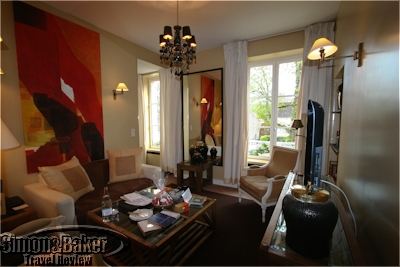
The living area in my junior suite
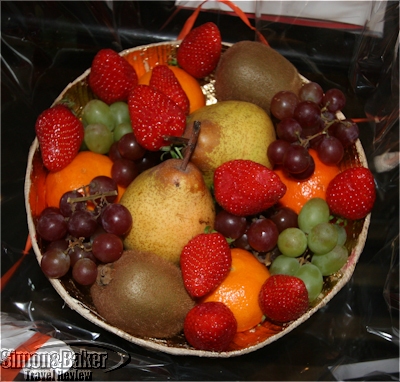
One of the amenities of my junior suite
After settling in in my junior suite one floor above the reception area I pulled on energy reserves to carry me through dinner at the famed L’Espérance de Marc Meneau restaurant, the hotel’s signature dining establishment. It was worth it. To allow my body to adjust to the new time I requested light options from the menu and refrained from imbibing any wine with dinner. The meal was just what I needed and the setting, facing a landscaped garden in the dim light of evening, was beautiful even in the rain and cold of early spring.
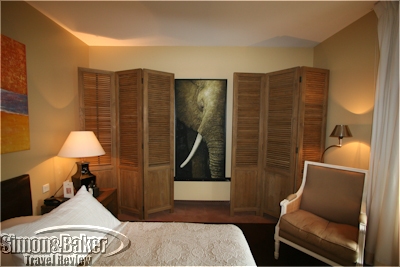
The bedroom had an Africa theme
The 32-room four-star hotel was spread into several buildings within easy walking distance from the two-story main building where reception, the bar and restaurants were located. One of my favorite areas of the property were the manicured gardens. Even in early spring they were striking. The gourmet restaurant, the bistro and many of the common area of the main building faced or had a view of the gardens named in memory of Serge Gainsbourg, a friend of the owners who had spent time at their property.
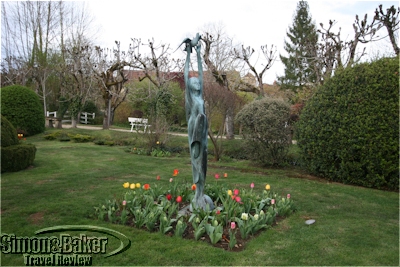
The hotel garden named for Serge Gainsbourg
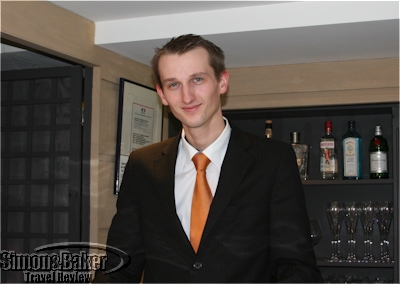
One of the attentive staff members of the hotel
My elegant Africa themed junior suite, one floor up via circular stairs, was well appointed and pretty while at the same time comfortable. Although the view of the main parking lot from my room was less than stellar I was glad to be in the main building with quick and easy indoor access, sheltered from the nonstop rain, to hotel facilities.
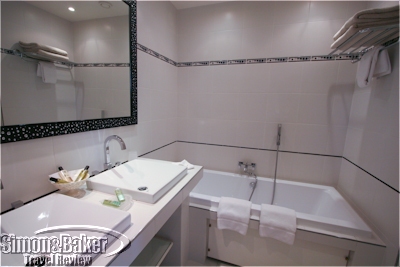
The bathroom in my junior suite
The junior suite, Room 106, had a spotless and spacious bathroom with a bathtub and separate shower. I appreciated the modern conveniences such as complimentary high speed WiFi, television, DVD player and a sound system; and amenities such as thick bathrobe, slippers, Italian toiletries and bitter almond scented Keiji soap, welcome fruit bowl and a box each of house nougat and caramels. Sounds carried. Inside my room I could sometimes hear voices in the hallway and the voices of my next door neighbors, wood creaking, staff cleaning in the morning, and mostly the daytime sounds of drilling and hammering from the construction work on the top floor, right above my suite.

A view of the gardens from Le Bistrot Gainsbourg
There were two types of breakfast, served in a garden facing lounge and in the library from 7:30 a.m. until 11 a.m., Continental (28 euros) and Complet (35 euros). After a few minutes a friendly and attentive server brought me fresh squeezed sweet pulpy orange juice, bowl of fresh fruit (grapes, kiwi, tangerine, strawberries, pear), bowl of mango, small bowl of yogurt, basket of bread and pastries (croissant, pain au chocolate), three types of jam, two small slices of Croque Monsieur (grilled ham and cheese sandwich) and my choice of hot beverage. I ordered chocolate which was served in a large bowl with extra chocolate in a carafe. Although the temperature was hot the chocolate flavor was a bit weak. Breakfast was quite satisfying.
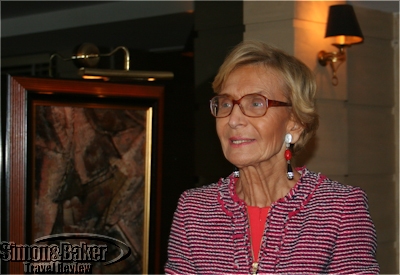
Francoise Meneau
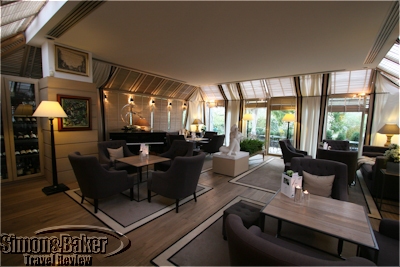
The hotel areas were light filled with ample views of the adjacent gardens
Although I generally prefer exploring independently I sometimes take advantage of tour options. That was the case on this trip. The hotel offered tours of area attractions. During my stay, I had time for an escorted walk, in the rain, around Saint Pere, the tiny village that is home to the hotel and restaurant, and to visit Vezelay, its better known popular neighbor. I would gladly return to the hotel (and restaurant) and dedicate more time to exploring the environs.




























































